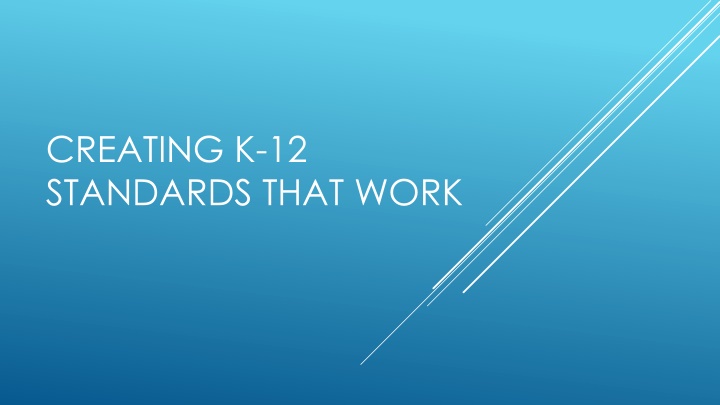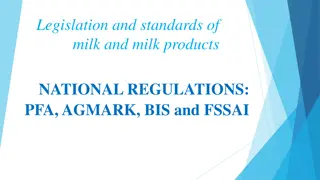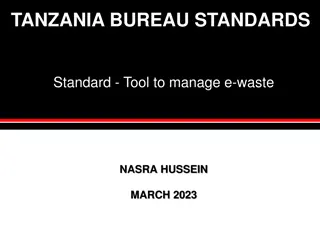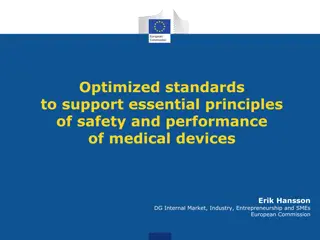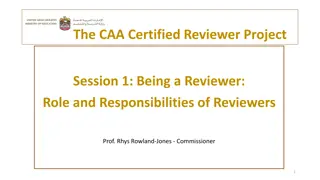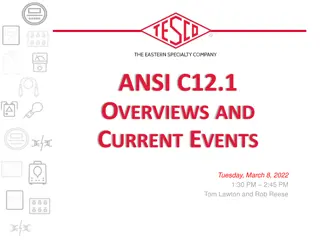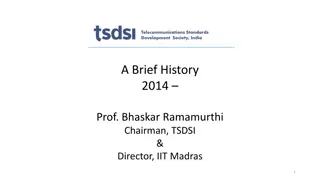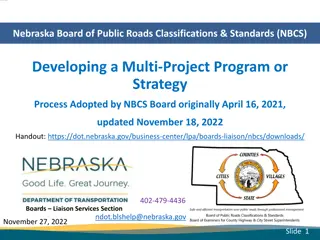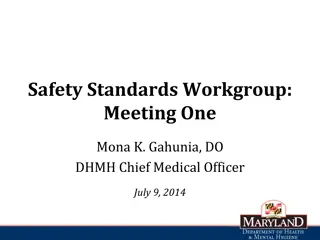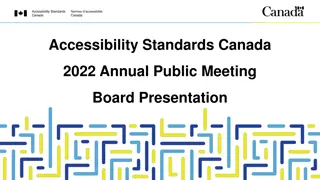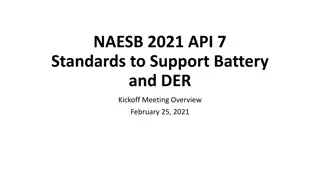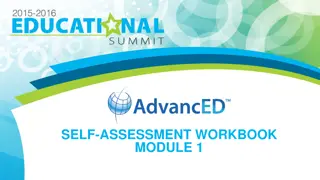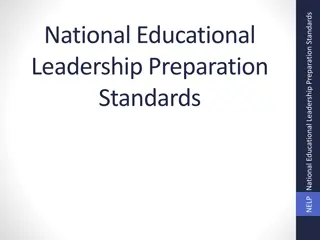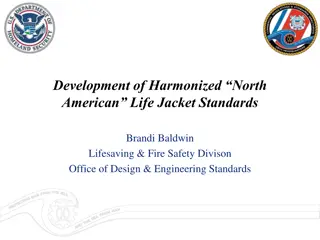Effective Strategies for Developing K-12 Standards
Veteran mathematician Larry Gray shares his successful experience in creating impactful K-12 math standards, emphasizing the importance of quality ingredients, expert preparation, and thorough collaboration. The process involves forming committees with diverse expertise and stakeholder involvement to ensure effective standards development resulting in improved student outcomes.
Download Presentation

Please find below an Image/Link to download the presentation.
The content on the website is provided AS IS for your information and personal use only. It may not be sold, licensed, or shared on other websites without obtaining consent from the author.If you encounter any issues during the download, it is possible that the publisher has removed the file from their server.
You are allowed to download the files provided on this website for personal or commercial use, subject to the condition that they are used lawfully. All files are the property of their respective owners.
The content on the website is provided AS IS for your information and personal use only. It may not be sold, licensed, or shared on other websites without obtaining consent from the author.
E N D
Presentation Transcript
CREATING K-12 STANDARDS THAT WORK
Veteran of the Minnesota Math Wars, 2000-2003 Negotiated a cease-fire so new Minnesota math standards could be written in 2003 Testified frequently at legislature, both as a critic and an advocate Co-chaired Minnesota Math Standards Revision Committee 2006-7 Revision became a thorough re-write, producing a successful set of standards that are still used today and for the foreseeable future 4thgraders first in nation, 8thgraders third in nation in both Percent Proficient and Percent Advanced on 2013 NAEP math tests MY NAME IS LARRY GRAY. I M A MATHEMATICIAN.
Great Standards Parent Confusion Teacher Frustration Political Pressures Public Opinion GREAT STANDARDS, POOR RESULTS
A great recipe is worthless without: Quality Ingredients Expert Preparation Carefully Planned Presentation Knowledgeable Appreciation SUCCESSFUL STANDARDS ARE LIKE A GOURMET DISH
Committee Definitions and Expectations Resources QUALITY INGREDIENTS
Committee (see Standards Revision Process handout) Chairs Content Experts Writers Consultants Other Stakeholders (e.g. parents, business/industry) Definitions and Expectations Resources QUALITY INGREDIENTS
Committee Chairs: Minnesota uses Co-chairs, one from Higher Ed and one from K-12 Provides both content expertise and links to K-12 community Look for people who will likely collaborate, appear publicly Content Experts Writers Consultants Other stakeholders (e.g. parents, business/industry) QUALITY INGREDIENTS
Committee Chairs: Content Experts: Must agree to prescribed content and expectations Look for those who cover many grade levels Representatives of urban and rural areas in state Minnesota has an online application system (see handout) Writers Consultants Other stakeholders (e.g. parents, business/industry) QUALITY INGREDIENTS
Committee Chairs: Content Experts: Writers: Subset of larger committee, possibly including co-chairs Broad and deep content knowledge Passionate about Vertical and Horizontal Integration Work closely with rest of committee on regular basis Consultants Other stakeholders (e.g. parents, business/industry) QUALITY INGREDIENTS
Committee Chairs: Content Experts: Writers: Consultants: Include experts who can t commit as much time Higher ed from both content and education sides Representatives of industry, teacher associations STATE ASSESSMENT staff regularly involved IMPORTANT! Other stakeholders (e.g. parents, business/industry) QUALITY INGREDIENTS
Committee Definitions and Expectations (see FAQ handout) College and/or Career Readiness Purposes and Audiences for Standards Beginning, Middle, End Structure of Standards Document Criteria for Standards Quality Resources QUALITY INGREDIENTS
Definitions and Expectations College and/or Career Readiness in Minnesota Math Standards: Ready to take Precalculus I (College Algebra) at the U of M This created buy-in from Higher Ed, and a pathway to STEM majors at U of M We could not define Career Readiness in meaningful way Purposes and Audiences Beginning, Middle, End Structure of Standards Document Criteria for Standards Quality QUALITY INGREDIENTS
Definitions and Expectations College and/or Career Readiness Purposes and Audiences for Standards in Minnesota: Expectations for achievement of K-12 students (teachers, parents) Graduation Requirements (teachers, higher ed, parents) State Tests must be aligned with Standards (test makers, teachers) Guide for designing Curricula (teachers) Beginning, Middle, End Flexibility in High School Curriculum Structure of Standards Document Criteria for Standards Quality QUALITY INGREDIENTS
Definitions and Expectations College and/or Career Readiness Purposes and Audiences Beginning, Middle, End of Math Standards in Minnesota: Beginning is K, with flexibility in K-2 (no state tests at that level) Middle is 8th grade, where legislature mandated Algebra I End is 9-11 combined for curriculum flexibility Flexibility in High School Curriculum Structure of Standards Document Criteria for Standards Quality QUALITY INGREDIENTS
Definitions and Expectations College and/or Career Readiness Purposes and Audiences Beginning, Middle, End Flexibility in High School Curriculum in Minnesota Math: Standards combined for Grades 9-11, tested near end of 11th grade Three main subject areas: Algebra, Geometry, Probability & Data Based on Algebra I in 8th grade Topics in Standards limited to those for which Mastery is expected (see FAQ) Students on track should take 4th high school math class (U of M requirement) Structure of Standards Document Criteria for Standards Quality QUALITY INGREDIENTS
Definitions and Expectations College and/or Career Readiness Purposes and Audiences Beginning, Middle, End Flexibility in High School Curriculum Structure of Standards Document in Minnesota Math Standards: Standards (main concepts) and Benchmarks (detailed skills and concepts) In Grades 3-8 and 11, all Standards must be tested each year Most, but not all, Benchmarks tested each year Strands: Number & Operation (through 8th), Algebra (K-11), Geometry and Measurement (K-11), Data Analysis (3-5) or Data Analysis & Probability (6-11) Strands in a Grade Level Connect to a few Focused Concepts (Horizontal Integration) Many Substrands apparent in structure and wording of document (Vertical Integration) Criteria for Standards Quality QUALITY INGREDIENTS
Definitions and Expectations College and/or Career Readiness Purposes and Audiences Beginning, Middle, End Flexibility in High School Curriculum Structure of Standards Document Criteria for Standards Quality in Minnesota: Do they work for Teachers and Test Makers? (clear, complete, consistent, checkable) Are they Grade-level Appropriate? Do the colleges and universities endorse w.r.t. College Readiness? Is the content sound, accurate, correct, up-to-date? Do they connect to the world around us? Do they promote literacy (technology, media, reading/writing)? Do they satisfy legislative requirements? Do they reflect a consistent feedback process from all stakeholders? Can student progress be monitored by school districts? QUALITY INGREDIENTS
CCSS Minnesota Domains Clusters Standards Benchmarks Grade K 9 30 5 13 1 11 30 6 20 2 10 34 7 20 3 11 40 9 26 4 12 43 8 27 5 11 43 9 27 6 9 50 10 33 7 9 45 11 34 8 10 42 8 35 9 to 11 47 127 11 71 Totals 139 484 84 306 One simple way to compare sets of standards
Committee Definitions and Expectations Resources considered authoritative by Minnesota for Math: Curriculum Focal Points (NCTM) American Diploma Project Standards (Achieve) Principles and Standards (NCTM) Legislative Requirements Previous Minnesota Standards QUALITY INGREDIENTS
Committee Definitions and Expectations Resources to be considered for Oklahoma Math Standards: Curriculum Focal Points (NCTM) American Diploma Project Standards (Achieve) Principles and Standards (NCTM) Legislative Requirements (including comparison to PASS) Previous Oklahoma Standards (PASS, Common Core) ACT Standards (all of them) Standards of one or two other states QUALITY INGREDIENTS
Ongoing feedback from many directions Appropriate Timelines In Minnesota, we only had 10 weeks from first math committee meeting until first expert reviews In Minnesota, 2007 Standards first tested in Spring 2011 Constant interaction with State Assessment, leading to clear, appropriate Test Specs missing in Minnesota in 2003 , did not happen with Common Core Math Vertical and Horizontal Integration EXPERT PREPARATION
NUMBER & OPERATION Fractions & Decimals: Operations Grades 5-7 6 Multiply and divide decimals, fractions and mixed numbers; solve real-world and mathematical problems using arithmetic with positive rational numbers. 6.1.3.1 Multiply and divide decimals and fractions, using efficient and generalizable procedures, including standard algorithms. 6.1.3.2 Use the meanings of fractions, multiplication, division and the inverse relationship between multiplication and division to make sense of procedures for multiplying and dividing fractions. 6.1.3.3 Calculate the percent of a number and determine what percent one number is of another number to solve problems in various contexts. 6.1.3.4 Solve real-world and mathematical problems requiring arithmetic with decimals, fractions and mixed numbers. 6.1.3.5 Estimate solutions to problems with whole numbers, fractions and decimals and use the estimates to assess the reasonableness of results in the context of the problem. 5 7 Add and subtract fractions, mixed numbers and decimals to solve real-world and mathematical problems. 5.1.3.1 Add and subtract decimals and fractions, using efficient and generalizable procedures, including standard algorithms. 5.1.3.2 Model addition and subtraction of fractions and decimals using a variety of representations. 5.1.3.3 Estimate sums and differences of decimals and fractions to assess the reasonableness of results. 5.1.3.4 Solve real-world and mathematical problems requiring addition and subtraction of decimals, fractions and mixed numbers, including those involving measurement, geometry and data. Calculate with positive and negative rational numbers, and rational numbers with whole number exponents, to solve real-world and mathematical problems. 7.1.2.1 Add, subtract, multiply and divide positive and negative rational numbers that are integers, fractions and terminating decimals; use efficient and generalizable procedures, including standard algorithms; raise positive rational numbers to whole- number exponents. 7.1.2.2 Use real-world contexts and the inverse relationship between addition and subtraction to explain why the procedures of arithmetic with negative rational numbers make sense. 7.1.2.3 Understand that calculators and other computing technologies often truncate or round numbers. 7.1.2.4 Solve problems in various contexts involving calculations with positive and negative rational numbers and positive integer exponents, including computing simple and compound interest. 7.1.2.5 Use proportional reasoning to solve problems involving ratios in various contexts. 7.1.2.6 Demonstrate an understanding of the relationship between the absolute value of a rational number and distance on a number line. Use the symbol for absolute value. TRACKING VERTICAL INTEGRATION of a SMALL SUB-STRAND
Public Comment Online Town Halls Expert Review Review by Higher Ed Legislature Teacher Conventions FAQ Document and Standards Webpage Bottom line: Get Buy-in! CAREFULLY PLANNED PRESENTATION
Frameworks (see Minnesota Frameworks handout) Data systems Professional Learning Communities Time and Patience It s all about the Teachers KNOWLEDGEABLE APPRECIATION
The State Education Commissioner Aided by the State Department of Education For details, see Standards Revision Process handout WHO IS THE CHEF?
Previous experience with PASS, Common Core Good people in charge who want to find out how to do it right Workable legislation WHAT OKLAHOMA HAS GOING FOR IT
Several changes in recent years Some political turmoil Starting all over, with a tight adoption date (Aug 1, 2016) Student achievement seems to be relatively low Lots of decisions to be made before starting Good Luck! WHAT ARE THE CHALLENGES FOR OKLAHOMA?
